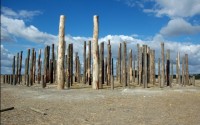Cuisine and feasting at Stonehenge: exploring the scientific evidence
- Date
- 27 Nov 2012
- Start time
- 7:30 PM
- Venue
- Tempest Anderson Hall
- Speaker
- Dr Oliver Craig

Cuisine and feasting at Stonehenge: exploring the scientific evidence
Dr Oliver Craig, BioArCh, Department of Archaeology, University of York
For millennia the enigmatic monument of Stonehenge has stood alone on Salisbury plain. Only now, following a new series of excavations, are we beginning to understand the monument in its wider context, through its relationship to a much broader landscape packed with other ceremonial spaces, houses and the debris of large-scale feasting. At the forefront of the new wave of Stonehenge archaeology has been the use of the latest scientific techniques to extract new information regarding the supply of materials, particularly food, needed to facilitate large ceremonial gatherings and sustain a resident population and to understand when, where and how these were consumed and discarded. From the pots and soils still smeared with the soot and grease from cooking to the animal teeth which contain chemical passports betraying their geographical origin, I will show how advances in archaeological science have revolutionised the study of prehistoric food, cuisine and consumption to provides a window into the daily lives and ritual activities of our Stone Age ancestors.
Download a poster for this event here: YPS 2012 11 27 Stonehenge
Report
Excavations at Stonehenge over some 400 years have destroyed half the site, and digging and recording procedures remained poor up to the 1950s when excavations to more modern standards occurred. The archaeological project of 2003-2009 was the first at Stonehenge for 50 years and sought to uncover living conditions in Neolithic times, both at Stonehenge itself and in the wider Wessex area where henges were more prolific than elsewhere in Britain. Remarkably well-preserved remains of a huge Neolithic village were unearthed, as were pits containing substantial artefacts of animal bones and pottery. Analysis suggested large numbers of people from all parts of Britain gathered in winter time over some 50 years, to build and worship in henges. There was scientific evidence that meat at the feasts came from as far afield as the Scottish highlands. Dr Craig drew an amusing analogy with Glastonbury today, and concluded by suggesting that these gatherings were ritualised celebrations of life and death, held in a unifying place of learning and sharing where similarities and differences in social identity were articulated.
Ken Hutson